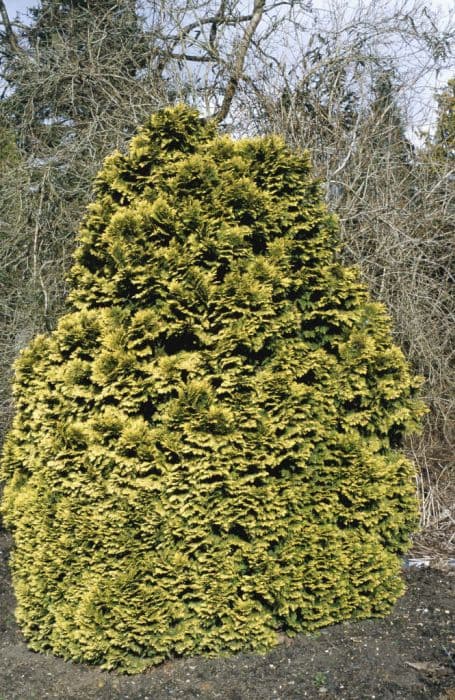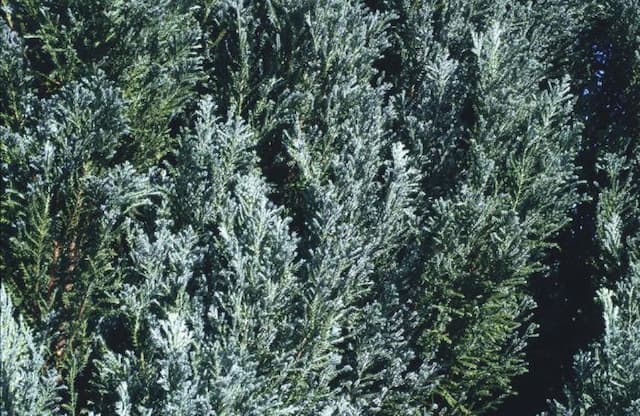Nootka Cypress Xanthocyparis nootkatensis 'Green Arrow'

ABOUT
The Green Arrow, also known as the Weeping Alaskan Cedar, is a striking ornamental conifer with a unique appearance. It has a strongly weeping habit, which means its branches and foliage tend to droop gracefully downward, creating a narrow and columnar silhouette. Its foliage is comprised of long, slender, dark green needles which hang off of the pendulous branches. As the foliage is evergreen, it retains its color throughout the year, offering a consistent and enduring aesthetic. The overall form of the Green Arrow is quite slender and elegant, which makes it a popular choice for adding vertical interest to landscape designs without occupying a lot of ground space. The texture of the Green Arrow's foliage is soft and feathery, adding to its graceful appearance. It produces small cones that are not particularly showy but add detail to the plant upon closer inspection. As an evergreen conifer, it does not have obvious flowers but relies on these cones for its reproductive cycle. The bark of the Green Arrow is also noteworthy, with a reddish-brown color that contrasts nicely with its dark green foliage and adds another layer of interest to the plant's appearance. Overall, the Green Arrow presents an upright, narrow form with a distinctive, pendulous charm. Its combination of soft, weeping needles and compact growth habit makes it a desirable choice for gardens where an accent of vertical line and texture is needed without overwhelming the space with a massive presence.
About this plant
 Names
NamesFamily
Cupressaceae
Synonyms
Green Arrow Weeping Alaskan Cedar, Green Arrow Nootka Cypress, Green Arrow Nootka Falsecypress
Common names
Cupressus nootkatensis 'Green Arrow', Callitropsis nootkatensis 'Green Arrow', Chamaecyparis nootkatensis 'Green Arrow', Xanthocyparis nootkatensis 'Green Arrow'.
 Toxicity
ToxicityTo humans
The plant commonly known as the Nootka Cypress 'Green Arrow' is not known to be significantly toxic to humans. Therefore, it does not generally cause poisoning when touched or ingested. However, as with many plants, individual sensitivity can vary and ingesting plant material may cause mild stomach upset in some cases.
To pets
Nootka Cypress 'Green Arrow' is not commonly listed as a toxic plant to pets. It is not known to cause serious poisoning in animals. However, ingestion of non-food items, including parts of this plant, can potentially lead to gastrointestinal upset, such as vomiting or diarrhea, in some pets due to the mechanical irritation or the sensitive nature of their digestive systems. It is always advisable to prevent pets from ingesting plants not intended for consumption.
 Characteristics
CharacteristicsLife cycle
Perennials
Foliage type
Evergreen
Color of leaves
Green
Height
20 feet [6 meters]
Spread
2 feet [0.6 meters]
Plant type
Tree
Hardiness zones
4
Native area
North America
Benefits
 General Benefits
General Benefits- Visual Appeal: 'Green Arrow' adds vertical interest to landscapes with its narrow, weeping form and attractive dark green foliage.
- Drought Tolerance: Once established, it is relatively drought tolerant, requiring minimal supplemental water under normal weather conditions.
- Low Maintenance: This cultivar generally requires little pruning or other care once it is established in an appropriate location.
- Wildlife Habitat: Can provide shelter for birds and other wildlife within its dense foliage.
- Cold Hardy: It is capable of withstanding colder temperatures, making it suitable for planting in many northern climates.
- Year-Round Interest: This evergreen maintains its foliage throughout all seasons, offering greenery even in the midst of winter.
- Erosion Control: Its root system can help stabilize soil and prevent erosion, especially on slopes or in areas with loose soil.
- Privacy Screen: Due to its tall and narrow growth habit, 'Green Arrow' can be used to create a natural, living privacy screen or windbreak.
- Adaptable: It's versatile enough to be used in a variety of settings, such as urban gardens, parks, and large estates.
- Longevity: As a conifer, it can live for many years, providing long-term structure and stability in garden design.
 Medical Properties
Medical PropertiesThis plant is not used for medical purposes.
 Air-purifying Qualities
Air-purifying QualitiesThis plant is not specifically known for air purifying qualities.
 Other Uses
Other Uses- The dense, narrow growth habit of Green Arrow makes it an excellent choice for vertical accents in tight urban gardens where space is limited.
- Its wood can be used for specialty woodworking projects, such as inlays and small wooden crafts where a fine-grain, aromatic wood is desired.
- Green Arrow branches may be utilized in floral arrangements to provide a unique evergreen texture and a strong vertical element.
- This plant can be employed in noise reduction strategies for landscape design, as its thick foliage can help dampen sound.
- The tree can serve as a privacy screen, growing in a slender columnar form that requires little lateral space.
- In habitats suitable for wildlife, the dense foliage of Green Arrow can provide nesting sites for birds and other small animals.
- Green Arrow, with its weeping form, can be used as a living sculpture or focal point in contemplative gardens, such as Zen or meditation gardens.
- The plant may be included in theme gardens to replicate the forested regions of the Pacific Northwest where its species is native.
- It can be used in landscape designs that require vertical layering, adding structural diversity without overshadowing smaller plants.
- Due to its resistance to deer browsing, Green Arrow can be a good choice for gardens in areas with high deer populations.
Interesting Facts
 Feng Shui
Feng ShuiThe Nootka Cypress is not used in Feng Shui practice.
 Zodiac Sign Compitability
Zodiac Sign CompitabilityThe Nootka Cypress is not used in astrology practice.
 Plant Symbolism
Plant Symbolism- Resilience: Xanthocyparis nootkatensis 'Green Arrow', commonly known as the Nootka Cypress or Alaska Cedar, often grows in difficult environments, symbolizing the ability to withstand hardships and bounce back.
- Longevity: This species can live for a very long time, with some trees reaching ages of well over a thousand years, representing enduring life and everlasting nature.
- Protection: In certain cultures, evergreen trees like the Nootka Cypress are thought to have protective qualities, offering shelter and a haven for various forms of wildlife, symbolically providing guardianship and safety to people.
- Peace: Evergreens are also commonly seen as symbols of peace and tranquility, with their constant green presence year-round offering a calming influence.
- Purity: The coniferous nature of the tree, with its refreshing scent and clean lines, is often associated with purity and cleanliness.
- Growth: With its 'Green Arrow' cultivar known for its upward growth and narrow form, this tree can symbolize the aspiration and pursuit of personal growth or goals.
 Water
WaterThe Weeping Alaskan Cedar, commonly referred to as 'Green Arrow', prefers consistent moisture but does not do well in wet, waterlogged soils. It's important to water this plant thoroughly when the top inch of soil feels dry, which typically equates to about once a week, depending on weather conditions. During the growing season, approximately 1-2 gallons per week for young trees may be sufficient, but this amount should be adjusted based on rainfall and temperature. During the winter, reduce watering but do not let the tree dry out completely. It's crucial to water the tree slowly and deeply to encourage strong root growth.
 Light
Light'Green Arrow' Weeping Alaskan Cedar thrives best in full sun to partial shade. An ideal location would receive at least 6 hours of direct sunlight a day, but it can also tolerate spots with dappled light. Avoid deep shade as it can weaken the plant and lead to sparse foliage.
 Temperature
TemperatureWeeping Alaskan Cedar prefers cool to moderate temperatures and is hardy in a range between 20 to 70 degrees Fahrenheit. It can withstand cold down to about -10 to -20 degrees Fahrenheit, making it suitable for many temperate regions. The ideal temperature for robust growth tends to be within the range of 50 to 65 degrees Fahrenheit.
 Pruning
PruningPruning the 'Green Arrow' Weeping Alaskan Cedar is mainly done for shape and to remove any dead or damaged branches. Pruning should be done in late winter or early spring before new growth starts. This conifer seldom needs heavy pruning, and any necessary shaping should maintain its natural, narrow form. Remove only what is necessary to keep the tree looking its best, typically once a year.
 Cleaning
CleaningAs needed
 Soil
SoilThe 'Green Arrow' Weeping Alaska Cedar thrives in well-draining, moist soil with an acidic to neutral pH, typically between 5.5 and 7.0. A good soil mixture for this plant can be made with equal parts of loamy garden soil, coarse sand, and peat or compost to ensure proper drainage and fertility.
 Repotting
Repotting'Green Arrow' Weeping Alaska Cedar is a slow-growing conifer and typically does not need frequent repotting. When young, it might be repotted every 3-4 years, but as it matures, repotting can be done less often and only when the plant outgrows its current container.
 Humidity & Misting
Humidity & Misting'Green Arrow' Weeping Alaska Cedar prefers a moderate humidity level but is adaptable to various humidity conditions as long as it is not in an overly dry environment. Ensuring good air circulation is important for the health of the plant.
 Suitable locations
Suitable locationsIndoor
Bright light, cool room, don’t overheat, mist occasionally.
Outdoor
Full sun to partial shade, shelter from harsh winds.
Hardiness zone
4-8 USDA
 Life cycle
Life cycleThe life of the 'Green Arrow' Alaska Cedar (Xanthocyparis nootkatensis 'Green Arrow') begins with seed germination, which typically occurs in a well-drained, moist soil environment. Seedlings establish a root system and start to develop into juvenile plants, exhibiting rapid growth and the formation of distinctive, narrow, conical shape with dense, weeping branches. As it enters maturity, the Alaska Cedar continues to grow taller and may reach over 35 feet in height, with the foliage darkening to a rich green hue. Reproductive maturity is reached when the tree starts to produce cones; small male pollen cones and larger female seed cones, which are wind-pollinated. After pollination and seed maturation, seeds are dispersed by wind, allowing for the potential colonization of new areas. The lifespan of 'Green Arrow' can extend over many decades, during which old and damaged branches may be shed, and the plant may respond to environmental stresses through adaptive growth patterns.
 Propogation
PropogationPropogation time
Spring-Early Summer
Propogation: Xanthocyparis nootkatensis 'Green Arrow', commonly known as Weeping Alaska Cedar, is typically propagated through semi-hardwood cuttings. The optimal time for taking cuttings is during the summer months when the new growth has begun to mature but is not yet fully hardened. A common method for propagating this plant involves selecting a healthy branch and cutting a piece between 4 to 6 inches long. The cut end of the branch is then dipped in rooting hormone before being placed in a well-draining rooting medium such as a mix of peat and perlite. The cutting needs to be kept in a warm and humid environment, with indirect sunlight to encourage root development, which usually begins within a few weeks to a couple of months. Regular misting is recommended to maintain humidity levels, but care should be taken to ensure that the medium does not become overly wet, which could lead to rot. Once the cuttings have rooted and show new growth, they can be transplanted into individual pots to continue their growth.









